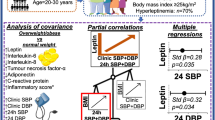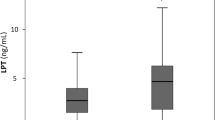Abstract
Objective:
To verify whether platelet responsiveness to leptin is associated with metabolic syndrome risk factors.
Design:
Cross-sectional study.
Subjects:
We studied 169 consecutive patients, mean age=43.6±9.9 years, with overweight (N=57) or obesity (N=112).
Measurements:
Cluster analysis was used to generate three clusters based on platelet responsiveness to increasing doses of leptin. Profiles of metabolic syndrome risk factors of the three clusters were compared by discriminant analysis.
Results:
Platelet responsiveness to leptin was absent in cluster 1, whereas cluster 3 had the greatest platelet aggregation response to leptin pre-incubation. Plasma leptin levels significantly decreased from cluster 1 to cluster 3 in both gender. Patients in cluster 2 had an intermediate profile of leptin responsiveness. Highest body mass index (BMI) values were more frequent in non-responders, whereas the prevalence of high waist circumference, as well as hypertriglyceridemia and hypertension, increased with increasing responsiveness to leptin from cluster 1 to cluster 3. Pattern of metabolic syndrome risk factors qualified as group specific in 69.0% of the cluster 1, 54.9% of the cluster 2 and 55.8% of the cluster 3. Circulating leptin, waist circumference, plasma triglycerides and BMI defined distinctive patterns of metabolic syndrome risk factors in the clusters.
Conclusions:
In overweight and obese outpatients, metabolic syndrome risk factors parallel to some extent platelet responsiveness to leptin. Such a correlation involves plasma leptin levels, waist circumference, plasma triglycerides and BMI, and may contribute to the excess risk of cardiovascular events in overweight and obese patients.
This is a preview of subscription content, access via your institution
Access options
Subscribe to this journal
Receive 12 print issues and online access
$259.00 per year
only $21.58 per issue
Buy this article
- Purchase on Springer Link
- Instant access to full article PDF
Prices may be subject to local taxes which are calculated during checkout

Similar content being viewed by others
References
Kaplan NM . The deadly quartet: upper-body obesity, glucose intolerance, hypertriglyceridemia and hypertension. Arch Intern Med 1989; 149: 1514–1520.
DeFronzo RA, Ferrannini E . Insulin resistance: a multifaceted syndrome responsible for NIDDM, obesity, hypertension, dyslipidemia, and atherosclerosic cardiovascular disease. Diabetes Care 1991; 14: 173–194.
Howard G, O’Leary DH, Zaccaro D, Haffner S, Rewers M, Hamman R et al. Insulin sensitivity and atherosclerosis. The insulin resistance atherosclerosis study (IRAS) investigators. Circulation 1996; 93: 1809–1817.
Fuster V, Badimon L, Badimon JJ, Chesebro JH . The pathogenesis of coronary artery disease and the acute coronary syndrome. N Engl J Med 1992; 326: 310–318.
Loskutoff DJ, Samad F . The adipocyte and hemostatic balance in obesity: studies of PAI-1. Arterioscl Thromb Vasc Biol 1998; 18: 1–6.
Zhang Y, Proenca R, Maffei M, Barone M, Leopold L, Friedman JM . Positional cloning of the mouse ob gene and its human homologue. Nature 1994; 372: 425–432.
Campfield LA, Smith FJ, Guisez Y, Devos R, Burn P . Recombinant mouse ob protein: evidence for a peripheral signal linking adiposity and central neural networks. Science 1995; 269: 546–548.
Lord GM, Matarese G, Howard JK, Baker RJ, Bloom SR, Lechler RI . Leptin modulates the T-cell immune response and reverses starvation-induced immunosuppression. Nature 1998; 394: 897–901.
Sierra-Honigmann MR, Nath AK, Murakami C, Garcia-Cardena G, Papapetropoulos A, Sessa WC et al. Biological activation of leptin as an angiogenic factor. Science 1998; 281: 1683–1686.
Ducy P, Amling M, Takeda S, Priemel M, Schilling AF, Beil FT et al. Leptin inhibits bone formation through a hypothalamic relay: a central control of bone mass. Cell 2000; 100: 197–207.
Chehab FF, Lim ME, Lu R . Correction of the sterility defect in homozygous obese female mice by treatment with the human recombinant leptin. Nat Genet 1996; 12: 318–320.
Lee GH, Proenca R, Montez JM, Carroll KM, Darvishzadeh JG, Lee JI et al. Abnormal splicing of the leptin receptor in diabetic mice. Nature 1996; 379: 632–635.
Tartaglia LA, Dembski M, Weng X, Deng N, Culpepper J, Devos R et al. Identification and expression cloning of a leptin receptor, OB-R. Cell 1995; 83: 1263–1271.
Nakata M, Yada T, Soejima N, Maruyama I . Leptin promotes aggregation of human platelets via the long form of its receptor. Diabetes 1999; 48: 426–429.
Konstantinides S, Schafer K, Koschnick S, Loskutoff DJ . Leptin-dependent platelet aggregation and arterial thrombosis suggests a mechanism for atherothrombotic disease in obesity. J Clin Invest 2001; 108: 1533–1540.
Bodary PF, Westrick RJ, Wickenheiser KJ, Shen Y, Eitzman DT . Effect of leptin on arterial thrombosis following vascular injury in mice. JAMA 2002; 287: 1706–1709.
Konstantinides S, Schafer K, Neels JG, Dellas C, Loskutoff DJ . Inhibition of endogenous leptin protects mice from arterial and venous thrombosis. Arterioscler Thromb Vasc Biol 2004; 24: 2196–2201.
Corsonello A, Malara A, Ientile R, Corica F . Leptin enhances adenosine diphosphate-induced platelet aggregation in healthy subjects. Obes Res 2002; 10: 306.
Corsonello A, Perticone F, Malara A, De Domenico D, Loddo S, Buemi M et al. Leptin-dependent platelet aggregation in healthy, overweight and obese subjects. Int J Obes Relat Metab Disord 2003; 27: 566–573.
Corsonello A, Malara A, De Domenico D, Perticone F, Valenti A, Buemi M et al. Identifying pathways involved in leptin-dependent aggregation of human platelets. Int J Obes Relat Metab Disord 2004; 28: 979–984.
Giandomenico G, Dellas C, Czekay RP, Koschnick S, Loskutoff DJ . The leptin receptor system of human platelets. J Thromb Haemost 2005; 3: 1042–1049.
Grundy SM, Cleeman JI, Daniels SR, Donato KA, Eckel RH, Franklin BA et al. Diagnosis and management of the metabolic syndrome. An American Heart Association/National Heart, Lung, and Blood Institute scientific statement. Circulation 2005; 112: 2735–2752.
National Cholesterol Education Program (NCEP) Expert Panel on Detection, Evaluation, and Treatment of High Blood Cholesterol in Adults (Adult Treatment Panel III). Third report of the National Cholesterol Education Program (NCEP) Expert Panel on Detection, Evaluation, and Treatment of High Blood Cholesterol in Adults (Adult Treatment Panel III) final report. Circulation 2002; 106: 3143–3421.
Nieuwdorp M, Stroes ES, Meijers JC, Buller H . Hypercoagulability in the metabolic syndrome. Curr Opin Pharmacol 2005; 5: 155–159.
Trenchard PM, Morgan RA . Sub-ambient aggregometry: a tool for examining platelet storage at any temperature between 4–22°C. Haemostasis 1986; 16: 352–361.
Hartigan JA . Clustering Algorithms. John Wiley & Sons Inc.: New York, 1975.
Norusis MJ . Predicting cure and credit: discriminant analysis. In: SPSS/PC+ Advanced Statistics V2.0. SPSS Inc.: Chicago, IL, 1988, pp B1–B39.
Carr DB, Utzschneider KM, Hull RL, Kodama K, Retzlaff BM, Brunzell JD et al. Intra-abdominal fat is a major determinant of the National Cholesterol Education Program Adult Treatment Panel III criteria for the metabolic syndrome. Diabetes 2004; 53: 2087–2094.
Lemieux I, Pascot A, Couillard C, Lamarche B, Tchernof A, Almeras N et al. Hypertriglyceridemic waist: a marker of the atherogenic metabolic triad (hyperinsulinemia; hyperapolipoprotein B; small, dense LDL) in men? Circulation 2000; 102: 179–184.
Park YW, Zhu S, Palaniappan L, Heshka S, Carnethon MR, Heymsfield SB . The metabolic syndrome: prevalence and associated risk factor findings in the US population from the Third National Health and Nutrition Examination Survey, 1988–1994. Arch Intern Med 2003; 163: 427–436.
Steinberg HO, Brechtel G, Johnson A, Fineberg N, Baron AD . Insulin-mediated skeletal muscle vasodilation is nitric oxide dependent. A novel action of insulin to increase nitric oxide release. J Clin Invest 1994; 94: 1172–1179.
Baron AD . Vascular reactivity. Am J Cardiol 1999; 84: 25J–27J.
Trovati M, Mularoni EM, Burzacca S, Ponziani MC, Massucco P, Matiello L et al. Impaired insulin-induced platelet antiaggregating effect in obesity and in obese NIDDM patients. Diabetes 1995; 44: 1318–1322.
Kjalke M, Silveira A, Hamsten A, Hedner U, Ezban M . Plasma lipoproteins enhance tissue factor-independent factor VII activation. Arterioscler Thromb Vasc Biol 2000; 20: 1835–1841.
Doggen CJ, Smith NL, Lemaitre RN, Heckbert SR, Roosendaal FR, Psaty BM . Serum lipid levels and the risk of venous thrombosis. Arterioscler Thromb Vasc Biol 2004; 24: 1970–1975.
Takahashi Y, Chiba H, Matsuno K, Akita H, Hui SP, Nagasaka H et al. Native lipoproteins inhibit platelet activation induced by oxidized lipoproteins. Biochem Biophys Res Commun 1996; 222: 453–459.
Englyst NA, Taube JM, Aitman TJ, Baglin TP, Byrne CD . A novel role for CD36 in VLDL-enhanced platelet activation. Diabetes 2003; 52: 1248–1255.
Jarvis GE, Atkinson BT, Snell DC, Watson SP . Distinct roles of GPVI and integrin alpha(2)beta(1) in platelet shape change and aggregation induced by different collagens. Br J Pharmacol 2002; 137: 107–117.
Canavan B, Salem RO, Schurgin S, Koutkia P, Lipinska I, Laposata M et al. Effects of physiological leptin administration on markers of inflammation, platelet activation, and platelet aggregation during caloric deprivation. J Clin Endocrinol Metab 2005; 90: 5779–5785.
Mantzoros CS, Moschos S, Avramopoulos I, Kaklamani V, Liolios A, Doulgerakis DE et al. Leptin concentrations in relation to body mass index and the tumor necrosis factor-α system in humans. J Clin Endocrinol Metab 1997; 82: 3408–3413.
Shimizu H, Shimomura Y, Hayashi R, Ohtani K, Sato N, Futawari T et al. Serum leptin concentration is associated with total body fat mass, but not abdominal fat distribution. Int J Obes 1997; 21: 536–541.
Corica F, Allegra A, Corsonello A, Buemi M, Calapai G, Ruello A et al. Relationship between plasma leptin levels and the tumor necrosis factor-α system in obese subjects. Int J Obes 1999; 23: 355–360.
Friedman JM, Halaas JL . Leptin and the regulation of body weight in mammals. Nature 1998; 395: 763–770.
Haynes WG . Role of leptin in obesity-related hypertension. Exp Physiol 2005; 90: 683–688.
Acknowledgements
This work is partially supported by grants from the Italian Ministry for Education, University and Scientific Research.
Author information
Authors and Affiliations
Corresponding author
Rights and permissions
About this article
Cite this article
Corica, F., Corsonello, A., Lucchetti, M. et al. Relationship between metabolic syndrome and platelet responsiveness to leptin in overweight and obese patients. Int J Obes 31, 842–849 (2007). https://doi.org/10.1038/sj.ijo.0803476
Received:
Revised:
Accepted:
Published:
Issue Date:
DOI: https://doi.org/10.1038/sj.ijo.0803476



